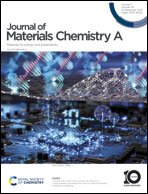Uncovering the influence of the modifier redox potential on CO2 reduction through combined data-driven machine learning and hypothesis-driven experimentation†‡
Abstract
In recent years, Cu-based catalysts have attracted attention for their ability to reduce CO2 into various C2+ products. Surface organic modification of Cu has been shown to tune the selectivity effectively. However, such a modification effect is complex, especially considering the diverse catalyst preparation procedures and testing conditions. In this work, we analyzed the literature data on the catalytic performance of organics-modified Cu and bare Cu for comparison. We calculated the change in the faradaic efficiency of C2+ products after organic modification. We analyzed these changes using machine learning, which showed an unexpected correlation between the electronic structure of the modifiers and the faradaic efficiency. To test this data-inspired hypothesis, we experimentally constructed a series of alkyne-conjugated polymers as the Cu surface modifiers, confirming such a correlation between the monomer reduction potential and the C2+ selectivity of the modified Cu catalysts. Our work demonstrates the significance of combining data-driven and hypothesis-driven approaches to uncover new insights into the design of effective CO2 electroreduction catalysts.



 Please wait while we load your content...
Please wait while we load your content...